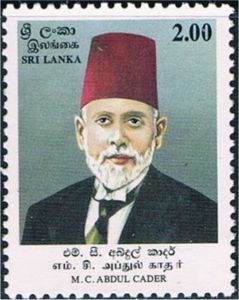
Everyone knows of the vagaries that sartorial styles are subjected to. Today, more than ever, styles of dress and minor articles of dress like ties, shoes, head gear etc., seem to change with every change of wind ! We are aware that an important item of dress, the head cover and, for the Muslims, more than for any other community, this is very important and has not been spared these changes.
At least the older generation which has lived long enough to notice the changes that have taken place in the head gear of the Muslims, will have rather a sad tale to tell: if one would look back to some fifty years ago, one would remember that it was the fez cap that was considered regular and prescribed head cover for a Muslim in all walks of decent society – from any distinguished social gathering, right up to the Supreme Court. This reminds one, of the mighty pitched battle that was led from the front by doughty Batticoloa Advocate, Mr. Mohamed Careem Abdul Cader, to get the courts of Law, including the Supreme Court to accept the fez as regular and acceptable head cover as a part of the dress worn by Attorney (Muslim) at the Bar.
It was the year 1905, when, as everyone knows, British Colonial power was at its zenith, when Britain ruled the waves, when they could waive rules when it was convenient for them, but were no so willing to do so for the ‘natives’. It was before Chief Justice at the time, Sir Charles Layard, the doughty Muslim Advocate from Batticoloa, appeared on behalf of a client, wearing a red fez cap; the Chief Justice took one look and roared:
“Stand back Sir, you have a pair of boots, too, I see. You must take off your boots or remove your cap: unclothe yourself at one end. Otherwise you are showing disrespect to this Court.”
But Advocate Cader refused to do either. Thus was sparked off a bitter contest. The Muslims took the matter very seriously, they considered the order of the Chief Justice as an insult to their religion and to their community.
They lost no time in organizing a protest meeting at the premises of the Maradana Mosque: a Muslim lawyer from Bombay was got down to advise them and to address the gathering. Incidentally a photograph of the Organizing Committee set up for this purpose is available and, one cannot fail to notice how impressive this distinguished group looks.
There they are: Messrs S.L. Mohamed, Hadijiar, J.P., W.M. Abdul Rahman, Raffiuddin Hamed, Sir Mohamed Macan Marcar, Carimjee Jefferjee, Meera Lebbe Marikkar, M. C. Abdul Cader, I.L.M. Abudl Azeez, Meera Lebbe Marikkar and Abdul Careem. They sat down to plot out strategy and action and pursue them to the bitter end.
The Bombay lawyer addressing the meeting said that he had worn the fez before even the Queen of England (Queen Victoria) at the Buckingham Palace Court they now claimed the fez was decent, regular and acceptable item of head gear to be worn by Muslims at the Supreme Court Bar.Representations were made to the Governor at the time, Sir Henry Blake, and protests soon reached Whitehall and, on instructions received from there, the Governor intervened and it was finally decreed that the fez was appropriate head cover for Muslim lawyers to wear at the Courts of Law, including the Supreme Court.
Even as late as fifty years ago, the fez was quite commonly worn by Muslims at every important occasion; it was worn at school by Muslim students, and accrued no offence at any level. In villages, among the poorer Muslims, when they went out, very often they wore a large red kerchief folded round their heads; the fez incidentally was rather an expensive article, being manufactured out of felt and imported.
The fez probably originated in Turkey during the Oattoman empire which included most of the Middle East extending to the Balkans and Spain, and was widely used there until the social revolution initiated by Kamalk Aturturk, after which it went out of vogue in the country.
Today, in this country, most Muslims prefer not to wear not only the fez, but also any head cover when they go out. At the Mosque and funerals, because a head cover is considered mandatory, they would wear a white or coloured skull cap and those who don’t have even that would simply cover their heads with a small handkerchief. So the decline of the fez seems complete. One may guess that to most Muslims the fez seems rather odd and outlandish and perhaps, incompatible with modern sartorial modes: the young men today may not be easily persuaded to wear a fez out in the streets.
May 27th, this year marks the 57th death anniversary of this great man, M.C. Abdul Cader, the first Moor Graduate and Advocate who declined to remove his fez cap in the Supreme Court on the orders of the Chief Justice, thus setting off the great battle which he ultimately won for the Muslims of this country, restoring their dignity and self respect as a community, it behooves the Muslims, therefore to think of him with the honour and respect he deserves.
Post Disclaimer | Support Us
Support Us
The sailanmuslim.com web site entirely supported by individual donors and well wishers. If you regularly visit this site and wish to show your appreciation, or if you wish to see further development of sailanmuslim.com, please donate us
IMPORTANT : All content hosted on sailanmuslim.com is solely for non-commercial purposes and with the permission of original copyright holders. Any other use of the hosted content, such as for financial gain, requires express approval from the copyright owners.
 Sri lanka Muslims Web Portal Sri Lanka Muslims News Center
Sri lanka Muslims Web Portal Sri Lanka Muslims News Center
 Donate
Donate


